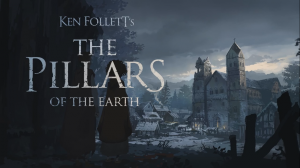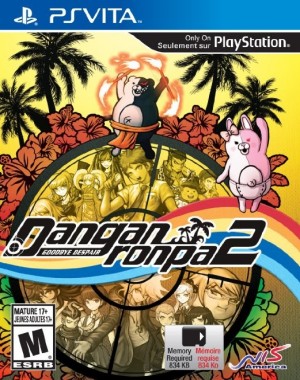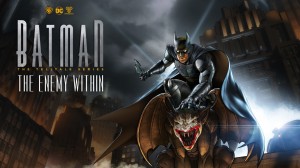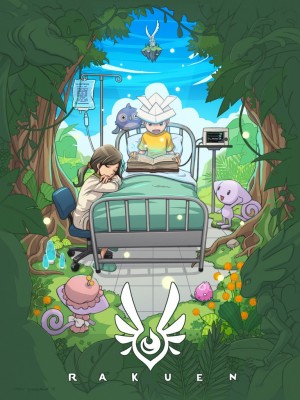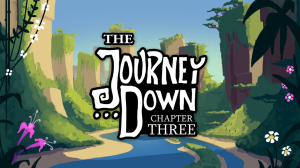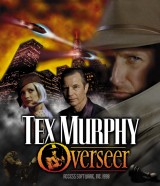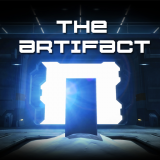Review for Hiveswap: Act 1

Remember way back to those halcyon days for gaming on Kickstarter, when that barely conceived adventure was pitched with no tangible plan and no actual assets yet still proceeded to rake in millions of crowdfunding dollars? Yes, that was a mighty impressive success story for Hiveswap.
[Cue sound of crickets…]
Oh, you thought perhaps I meant that Schafer guy? Well, the Double Fine Adventure may have hogged all the internal genre headlines at the time, but not long after came Andrew Hussie and his own campaign for an old-school point-and-click based on his popular web comic, Homestuck. While the adventure community may have stood around wondering what all the fuss was about (if they heard about it at all), the cartoon’s many devoted fans managed to chip in almost 2½ million dollars to see the franchise brought to life.
But then came the silence. If you thought the Broken Age delays were bad, that was nothing compared to the sparsity of updates from the Homestuck camp, and when the first details emerged, we found out that production of the game had changed hands and that the re-christened Hiveswap had become episodic (likely consisting of four installments). Ugh. Still, slowly but more-or-less surely from that point on, progress was made until the big day arrived for Act 1 a full five years after the game was announced.
All that’s not to cast aspersions on the developers. If there’s one thing we’ve learned about indie game creation, it’s that it is anything but an exact science and is almost guaranteed to encounter unexpected challenges, multiple missed deadlines, and much tighter budgeting than originally planned. It’s the nature of the business, and especially so for inexperienced teams like Hiveswap’s What Pumpkin Studios. And yet it’s important background, all leading up to the obvious question: Was it worth the wait (so far)?
I confess to knowing absolutely nothing about the Homestuck comic before this, and to be honest, a quick glance through the online archives didn’t much impress me. Perhaps it’s just not for me, or maybe it’s an acquired taste, but what I saw was a manic, crudely-drawn and partially-animated interactive story that was kind of all over the place. I can totally see that formula working for a web comic specifically designed for rapid-fire speed and daily audience participation. But those are probably the last characteristics you’d want from a full-fledged adventure game. So something had to give.
As it turns out, Hiveswap is very traditional in most respects, with its point-and-click interface and loads of player interaction, character dialogue, and actual puzzles to solve. In fact, it’s even more ambitious than most adventures, with multiple playable characters along the way. And while there are clearly hints of its MS Paint origins on display (mainly in the character models), the artistic design here is gorgeously drawn and generously animated. The music, too, is notable, if heavily over-used, giving the game a much more polished cinematic approach than its web-based forebear. Yet the game hasn’t totally abandoned its roots either, with just enough reserved mayhem to tap into those same manic sensibilities. These can feel awkwardly shoehorned in, but my main lament to this point is that it just isn’t very amusing for a game based on a comic. Wryly-written, yes. Laugh-out-loud funny, no.
The story begins peacefully enough with sister and brother Joey and Jude, respectively, playing giddily with the family dog in the backyard. And then all hell breaks loose. Monsters! Seemingly out of nowhere – but likely from the suspicious-looking castle seen off in the distance – a bunch of blobby creatures with too many limbs and gaping green mouths storm the house, causing Joey to flee inside for shelter while her brother holes up in his secret treehouse outside. Safe for now but not for long, Joey must find a way to contact Jude, and then make her way up to the attic. Easier said than done, especially when the power goes out, but adventure gamers would have it no other way.
Unlike so many story-driven releases these days, Hiveswap is a real, live adventure game. (No wonder it needed crowdfunding!) That means hotspots to click on, items to collect, and obstacles to overcome. These start out simple enough, like finding batteries for a flashlight, easing players into the simple mouse-based interface. Interactive items are aplenty, and clicking one will yield either an observation or a choice of actions, where applicable. Once you’ve established radio contact, you’ll also frequently interact with your sibling, making up for the fact that you spend most of your time alone. More than making up for it, in fact: this game is talkie, which turns out to be both a strength and arguably its biggest weakness.
I applaud the extra effort put into non-mandatory elements, and the commentary often provides insightful character background, whether highlighting a broken family’s dysfunction, Jude’s dorky neuroticism, or Joey’s disdain for their slovenly babysitter. There’s a lot you can learn about a household from discarded Chinese takeout cartons, a bulletin board full of newspaper conspiracy clippings, and a trophy room full of “inventive” taxidermy. Who knew? And what you can’t learn from the environmental storytelling, a peek at Joey’s diary (if you can get it unlocked) provides even more personal detail.
Yet with that benefit comes a few drawbacks, one of them serious. The main problem is, I lied when I called Hiveswap “talkie” because there is no actual talking at all. Instead, everything is displayed in subtitle boxes at the bottom of the screen, many of them quite lengthy. I realize the irony of a reviewer criticizing the amount of reading involved, but a game is not an article, and the sheer volume of text to sift through here begins to put a major crimp in the narrative momentum, particularly when the story implies urgency, as it often does. Before long I just wanted the protagonists to shut up and get on with it, though I didn’t dare skip anything for fear of missing something important. And note to all developers: put your speech boxes somewhere IN the view screen, not around it. Every time the player’s eye is forced to lurch up and down or back and forth across the screen, it creates a massive disconnect between the text and the action.
While I’m often willing to overlook the lack of voice-overs in small-budget games, it simply feels inexcusable in a production with this much financing behind it. Okay, maybe the hotspot monologues (which are curiously written like a text adventure, describing what “you” are doing at the time), but surely conversations could be voiced to help flesh out the characters, or at the very least the cinematics for added dramatic impact. And it’s not just the people who are short-changed. The monsters don’t roar, snore, or make other suitable sounds that circumstances clearly dictate, and even the walkie-talkie doesn’t crackle. Really the sound effects in general are so sparse as to be entirely underwhelming, though I did get a big kick out of the squeaky shoes on a polished floor. Hiveswap needs a decent foley artist, or at least a busier one.
That leaves the music to fill in most of the audio gaps, and while at first it offers a nice array of pieces ranging from synthesized chiptunes to moody piano to jaunty orchestral scores, it quickly becomes apparent just how short each track is, and then the repetition sets in. And then the repetition sets in. And then the repetition sets in. (Annoying, isn’t it?) Please, What Pumpkin: less music looping in future episodes, and more ambient atmosphere in its place.
It’s impossible to be too frustrated with the sound failings, however, in a game that looks this good. The hand-drawn backgrounds are beautifully designed, vibrantly coloured, and packed with detail. Whether it’s the tinted leaves of a lovely autumn scene, the many photos and posters lining the walls of a child’s room, or the ominous purple hue of an alien night sky (more on that shortly), Hiveswap is a feast of eye candy, periodically flavoured with dramatic changes in lighting. Contrasting the vivid colours are the noseless and largely black-and-white characters, an obvious nod to the original comic that has no real bearing on the game. They are richly animated, however, avoiding the usual adventure game shortcuts to show Joey breathing a deep sigh of relief when danger passes, a wounded “deer cat” (I said we’ll get to that) delivering an appreciative face-lick, or some fancy footwork to ward off rampaging creatures.
Yes, in between the standard and fairly straightforward inventory-based obstacles, you’ll encounter a few “boss fights” to overcome. Too many, really, but fear not, as this requires not a deftness of hand, but a proficiency of foot. Among Joey’s many passions, she’s a dancer whose tap and ballet talents enable her to show off her moves when called upon in unusual situations. Once “learned” (simply by finding the objects in question), icons for these abilities appear in the collapsible bar at the top of the screen. They can be used any time, even when least expected, such as in the middle of confrontations with strangely-silent snarling beasts. Each new fight sequence gets harder to complete, requiring new approaches and a bit of extra trial-and-error to work out, but there’s never any real danger, and dance moves mid-battle are accompanied by arcade-style comments like “Hot Steppin’” and “Pirouette-and-Bop,” so it’s all just a kind of knowing wink at ‘80s RPGs.
Actually, a little hand-eye coordination wouldn’t go amiss to help with a minigame that plays much like the old arcade classic Snake. It’s not that difficult, and in fact the harder of its two occasions requires a bit of puzzle-solving to crack an extraterrestrial alphabet (soon!) code word first, but you will need to do some nimble-fingered maneuvering to succeed. It looked like we’d be stuck playing the old electronic Simon game too, but this is fortunately interrupted as an unworthy challenge. Instead, it serves as just one of the many nods to the 1990s, the period during which the game is set, along with an interactive Lite-Brite, an unwanted Easy-Bake Oven, and evidence of a messy rubber dart gun war. (Are those things still around?) Not so nineties are the hexagonal CDs, stickball paraphernalia, and protective force fields.
Okay, NOW it’s time to talk about the other part of Hiveswap – or rather, the other part of this chapter of Hiveswap. While you spend the first half of the game controlling Joey and Jude, eventually Joey inadvertently triggers a portal to another world called Alternia, passing a “troll” (basically just a boy with horns and fangs) named Tetrarch Dammek going the other way mid-stream. We don’t experience anything of Dammek’s earthly visit just yet, but Joey soon befriends a nervous, telekinetic troll boy named Xefros. Essentially taking the place of Jude, the game continues the same as before, just with another secondary playable character (the two now communicating via tablet) and a whole new setting. Alternia has no adults, and is under siege by a ruthless leader named “the Heiress”, her mechanical drones invading the city just as Joey arrives. This planet has a different visual aesthetic and some distinct vocabulary, but it’s functionally similar in most respects, so the actual gameplay experience doesn’t change too much.
As an episodic series debut clocking in at a little under three hours, this particular installment ends with something of a cliffhanger, though less in the “OMG, what’s about to happen?!” sense than simply an obvious tease that more is yet to come, with stakes that are only going to get higher later on. Non-spoiler alert: Joey doesn’t make it back, so her adventure on an alien world under tyrannical rule is only getting started. And what the heck is going on at home while Joey’s off cavorting with low-esteem paranormal revolutionaries?
I can’t really comment on Hiveswap’s success in adapting the web comic to game form, but as an adventure game in its own right, it is certainly off to a promising start. Though old-school in its point-and-click approach, it’s a great looking modern game with plenty to see and touch and do – just not nearly enough to hear. The puzzles could be more complex and the script could do with more actual comedy, but the pieces are in place for a meatier challenge as the series progresses, and it’s clear that a lot of effort has gone into building not just one but two different worlds. It’s still very much in the early stages, but count me in for the long haul. Based on what I’ve seen so far, I’m of the mind to find out just how far this thing is prepared to go.
WHERE CAN I DOWNLOAD Hiveswap: Act 1 – Kansas City Shuffle
Hiveswap: Act 1 – Kansas City Shuffle is available at:
- GOG
- Itch.io -50%
- HumbleBundle











